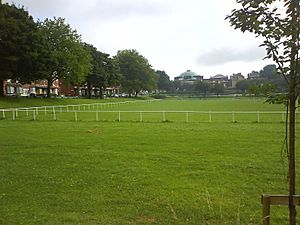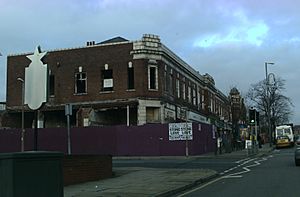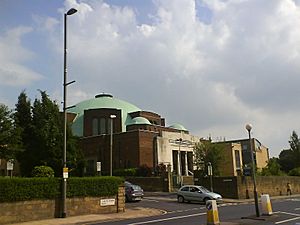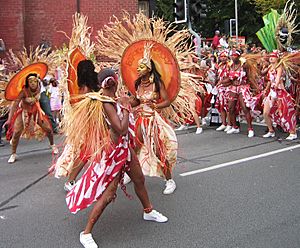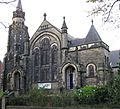Chapeltown, Leeds facts for kids
Quick facts for kids Chapeltown |
|
|---|---|
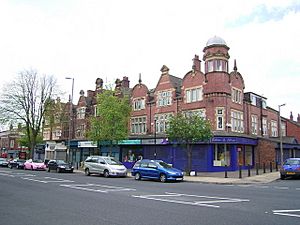 Chapeltown Road |
|
| OS grid reference | SE3093435637 |
| Metropolitan borough | |
| Metropolitan county | |
| Region | |
| Country | England |
| Sovereign state | United Kingdom |
| Post town | LEEDS |
| Postcode district | LS7 |
| Dialling code | 0113 |
| Police | West Yorkshire |
| Fire | West Yorkshire |
| Ambulance | Yorkshire |
| EU Parliament | Yorkshire and the Humber |
| UK Parliament |
|
Chapeltown is a suburb of north-east Leeds, in West Yorkshire, England. It is part of the Leeds City Council Ward of Chapel Allerton. It is approximately one mile north of Leeds city centre.
Contents
Location and boundaries
Chapeltown does not have any official boundaries. It is not recognised by the Land Registry or the Post Office, but is widely recognised by residents of Leeds. According to the Ordnance Survey Chapeltown is a relatively small area around National Grid Coordinates SE430500, 437500, north of Harehills Lane (B6159) and east of the Harrogate Road. Chapeltown Road runs north through Potternewton to Harehills Lane - that is it leads to Chapeltown but is not on it. According to one source a wider definition is in "the LS7 postal region, and can be mapped through four points; where Scott Hall Road runs to north to where it intersects with Potternewton Lane, where Harehills Lane runs east and intersects with Avenue Hill, where Spencer Place runs south and intersects with Roundhay Road, to the very bottom and beginning of Chapeltown Road." This is roughly the same as the boundary given in the Leeds Index of Deprivation, although the Scott Hall estate is excluded from Chapeltown. This follows the LS7 postcode boundary on the East, with LS8 being Harehills. Roundhay Road could also be considered the boundary between them. However, it is widely accepted that Markham Avenue and Gathorne Terrace are the dividing line between Chapeltown and Harehills. Harehills is adjacent, and the areas are commonly considered together.
Neighbouring areas to Chapeltown in Leeds include Chapel Allerton to the North, Scott Hall to the West (considered part of Meanwood by the council), Harehills to the east, Sheepscar to the south, and Potternewton either to the north or included. Taking the larger area, the main thoroughfare of Chapeltown is Chapeltown Road which runs through the centre of the area north-south for approx. 2 miles (3.2 km), linking Sheepscar Interchange (at the edge of Leeds city centre) and Harehills Lane/Chapel Allerton.
Chapeltown and Potternewton
There is overlap between the areas referred to as Chapeltown and Potternewton so that they can be two names for the same area. Potternewton is an historic village and most maps prioritise the name Potternewton over Chapeltown, but most residents of Leeds refer to the area as Chapeltown. Transport Direct uses both names, defining them as separate areas, but Potternewton is defined as a very small area around the north of Scott Hall Road and most of the area is classified as Chapeltown.
Potternewton Park is a spacious and attractive park in the north-east of the area which is the centrepiece of Europe's oldest West Indian Carnival; Leeds Carnival. Norma Hutchinson Park, a smaller playground and sports field, lies in the south of Chapeltown; it was previously named Buslingthorpe Recreation Ground and was renamed in 2009 to commemorate Jamaican-born local councillor Norma Hutchinson who died in 2004.
Chapeltown is frequently served by bus services 2, 3, 3A and 36. These buses run directly through the centre of the area via Chapeltown Road. There is also the hourly service 48, but it does not operate on evenings and Sundays. Regular service 91 runs along Harehills Lane.School buses also run through Chapeltown linking to high schools such as Cardinal Heenan, Carr Manor and Boston Spa.
Schools
Bracken Edge Primary School is located on Newton Garth adjacent to Potternewton Park. The school became reconstructed and extended in 2007. Hillcrest Primary School, off Cowper Street, is another prominent school in the area and has been known to host events such as PFS (playing for success). There is also Holy Rosary and St Annes Catholic School on Leopold Street. Further down the road was another school known as Leopold Primary School, which was closed down by 2002 because of overcrowding, becoming the Chapeltown Children Centre. Chapeltown Community Nursery is located on Reginald street.
History
The name Chapeltown is in origin a reduced form, first attested in 1427, of Chapel Allerton, and once denoted the same place. Thus Ralph Thoresby, writing in 1715, records Chapel-Town as a common name for the township of Chapel Allerton, describing it as "well situated in pure Air, upon a pleasant Ascent, which affords a Prospect of the Country ten or twelve miles". The open space to its east and north of Potter-Newton was "a delicate Green commonly call'd Chapel-Town Moor"."
Chapeltown Moor was in the manor of Newton (whence Potternewton), some 300 acres, used for races, archery contests, and in 1765 one of the first known cricket matches in Yorkshire, between "the Gentlemen of Chapeltown and the Gentlemen of Sheffield". By 1809 it was mostly enclosed.
In the nineteenth century, the area began to be constructed as a wealthy suburb, and many large terraces and villas from the period remain, though a large proportion have fallen into disuse or are divided up into smaller, low-rent flats. However the area remains leafy and architecturally notable. Buildings have been adapted over the years by successive communities who have settled in the area as places of worship and for a range of social uses. For example, the Union Chapel on Chapeltown Road became a synagogue and then a Sikh temple, although it is now disused following a period of disrepair and fire damage. Chapeltown Barracks were completed in 1820.
The building of Chapeltown
A map made of Leeds in 1834 shows the area that is now Chapeltown was pasture land between Chapel Allerton and Potternewton villages and Leeds. Through the centre of this farmland, which was already earmarked at this time as a planned 'New Town of Leeds' suburb, ran the Leeds-Harrogate Turnpike Road which later became Chapeltown Road. Much of this land, called 'Squire's Pastures' was part of Earl Cowper’s estate. The Earl first sold this land for development in 1825, but planning and building was slow, and the sale was not completed until 1873. Before selling his land, the Earl also set out a Deed of Arrangement defining the residential character of any future building including the limitation of livestock, heavy industry and public houses in the area.
By 1866 The area East of Chapeltown Road and North of Roundhay Road had acquired streets of pleasant houses intended for the growing middle class, and known as New Leeds.
Further north towards 'Potter Newton' work began in 1856 on Newton Grove. Work continued for the Lupton family on their Newton Park Estate following the housing designs of Charles Chorley and John Connon. The development continued to expand, including the addition of Sholebroke Avenue south of the Newton Park Estate by the 1880s.
In the next decade, the popularity of Chapeltown appears to have waned, in favour of areas further from the city. The remaining empty plots were filled with smaller, cheaper, terraced housing. By the start of the 20th century, the area was almost completely filled with housing.
The Lupton family residence of Newton Hall was demolished in the 1920s and the grounds were replaced with streets of semi-detached housing.
Little building work took place in Chapeltown throughout the twentieth century, unlike many other areas which were subject to slum clearances. Neighbouring Harehills was much the same. One reason that could have led to Chapeltown being left was the quality of its housing stock, although they now largely achieve low rents, the houses are generally well built as they were originally built for the influx of Leeds' new middle class brought on by the industrial revolution.
Population
Throughout its history Chapeltown has been home to successive emigre communities that have each added a new dimension to the culture, religious practices and heritage of the area.
Ashkenazi Jews fleeing pogroms in Eastern Europe towards the end of the 19th century that moved to Leeds tended to settle in the inner city area of the Leylands. Other groups of Jews also settled there, and synagogues were built. In the twentieth century many Jews moved north to the more desirable area of New Leeds/Chapeltown, and so did synagogues, so there were at one time 14 in Chapeltown. Along with neighbouring Harehills, where Montague Burton established his factory, this was a major area for tailoring and allied trades, which occupied many Jews, still remembered by the street name Button Hill.
In 1932 the Chapeltown Road New Synagogue, a large domed Byzantine style building, was opened. The opening was in time for the High Festivals of that year, with Rabbi Hurwitz delivering that first Shabbat Shuvah sermon. The artist David Hillman was commissioned, in 1935, to design three stained-glass windows for the shul in commemoration of the Silver Jubilee of King George V. These have since been moved to Shadwell Lane Synagogue. In the following decades the Jewish population in Chapeltown began to decline with many families moving further north to the Moortown area. In 1985 the synagogue closed and the building was bought by Leeds City Council. It is now home to the Northern School of Contemporary Dance.
The British African-Caribbean community in Leeds mostly came to the UK between the end of World War II and the early 1960s. Many of the first Jamaicans to settle in Leeds were ex-servicemen. In order to try to encourage mass immigration from the countries of the British Empire and Commonwealth to fill shortages in the labour market, the 1948 British Nationality Act gave British citizenship to all people living in Commonwealth countries, and full rights of entry and settlement in Britain. Many of the first generation of Jamaicans living in Chapeltown today immigrated in this period. The Jamaica Society was formed, with its headquarters in 277 Chapeltown Road to support the needs and celebrate the contributions of the African-Caribbean population in West Yorkshire and Leeds.
Culture and environment
The area is home to a wide range of community and creative organisations including the Northern School of Contemporary Dance, the Chapeltown house choir, the Host Media centre, and Leeds West Indian Centre (now famous for its club nights, particularly the monthly SubDub).
Chapel Allerton Hospital is found in the area, and is one of Leeds' main hospitals, though it does not have an Accident and Emergency department.
Carnival
Every August bank holiday weekend the area hosts the Leeds Carnival, second only in size to London's Notting Hill Carnival, however Leeds Carnival started in 1967 and predates that of Notting Hill. Arthur France, a Leeds University student from Saint Kitts helped to organise the first West Indian Carnival in Britain in Leeds in 1967. That year Vicki Celto was the first Carnival Queen for Leeds in a costume titled "Sun Goddess".
Northern School of Contemporary Dance
The NSCD is a modern conservatoire dance school with its origins in the Leeds dance education of the 1970s and 1980s. Two years after the founding of the school in 1985, it moved to its current home in Chapeltown in 1987. The Riley Theatre was built in the former synagogue, and over the next ten years a number of new dance studios were created on the site and the Brandsby Lodge was renovated. Today the school is a contemporary dance institution with nearly 200 students.
Religion
The changing population of the area is shown by the religious buildings, particularly along the Chapeltown Road. At the North end, by Chapel Allerton Hospital, is the 1976 Roman Catholic Church of Our Lady of Czestochowa & St. Stanislaw Kostka, serving the Polish community. (The Warsaw Stores on Chapeltown Road was a major source of Polish food in Leeds before a proliferation of Eastern European shops.) Further down is St Martin's Church, the original Anglican parish church of the village of Potternewton, now with a mainly West Indian congregation. Then comes the Church of God of Prophecy, a Pentecostal church with a mainly Afro-Caribbean congregation. Next door is the new Sikh Temple, the largest in Leeds. Opposite, now out of use, is a church which was originally a Union Chapel, then a Synagogue and then a Sikh Temple until the new one was constructed. Near the South end, the Holy Rosary Church was built in 1937 for the Irish Catholic community. Until 1985 the next building down was an impressive purpose-built synagogue, the largest in Leeds, which is now the Northern School of Contemporary Dance. The Roscoe Methodist Church on Francis Street (off Chapeltown Road) dates from 1974, but replaces a chapel founded in 1862.
Elsewhere, a former United Reformed Church (1906) has become the Chapeltown Community Church by Potternewton Park. The Church of the Three Hierarchs in Harehills Avenue is a former Methodist chapel reopened as a Greek Orthodox church in 1966. As late as 1993, maps showed four synagogues in the area including the main one, but these have all closed. The first mosque in Leeds was created in a house in Leopold Street in 1958. With the influx of Muslims from India and Pakistan in the 60s and 70s, larger buildings were acquired in 1974 and 1982 to become the main mosque in Leeds, and finally in 2001 the Central Jamia Mosque was completed on Spencer Place.
Notable residents of Chapeltown/Potternewton
- Frank Kidson (1855–1926), English folksong collector and music scholar, lived in Hamilton Avenue 1905–1926
- Edward Caldwell Spruce (1865–1923), sculptor, had a studio in Cowper Street
- Ellery Hanley MBE (born 1961), former Bradford Northern, Wigan, Balmain, Western Suburbs and Leeds Rugby League player and captain and later head coach of the Great Britain Rugby League team
- Brian Deane (born 1968), former footballer
- Olive Middleton née Lupton, great-grandmother of Catherine, Duchess of Cambridge who grew up at Newton Park Estate, Leeds
- Aaron Lennon (born 1987), footballer
- Kulvinder Ghir (born 1965), actor and comedian
- Micah Richards (born 1988), footballer
- Andre Wisdom (born 1993), footballer
- Arthur Currer Briggs, Lord Mayor of Leeds, 1903
- Eileen Taylor, Lord Mayor of Leeds from 2019 to 2021
- Cedric Clarke - Leeds' first black councillor
Location grid
 |
Chapel Allerton |  |
||
| Scott Hall | Harehills | |||
| Sheepscar |
See also
 In Spanish: Chapeltown para niños
In Spanish: Chapeltown para niños



